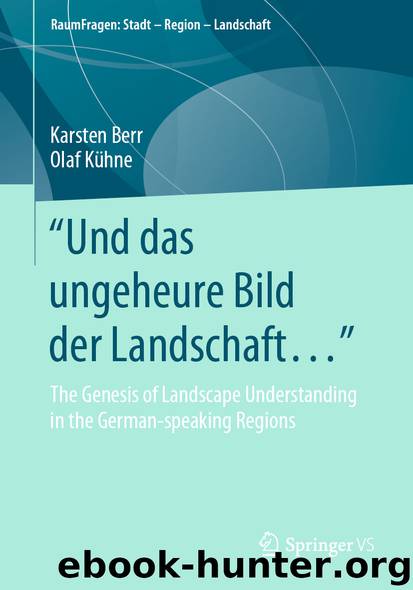“Und das ungeheure Bild der Landschaft…” by Karsten Berr & Olaf Kühne

Author:Karsten Berr & Olaf Kühne
Language: eng
Format: epub
ISBN: 9783658277567
Publisher: Springer Fachmedien Wiesbaden
4.5 A German Special Path: Landscape in German Geography, Illustrated by Comparison with Anglo-Saxon Geography
The development of the ‘expert special knowledge stocks’ on the subject of landscape is both subject-specific and differentiated, but there are also culture-specific influences (through certain landscape concepts), national research traditions, and influences of certain research personalities. In addition, there are specific discursive developments as well as scientific and educational policy framework conditions (such as the priority given to certain disciplines or whether and with what intensity they are taught in schools). In the following, the path of Anglo-Saxon geography in comparison to German-speaking (especially human) geography will be outlined with the aim of contextualizing certain developments and logics of German-language landscape research. An essential characteristic of German-language human geography is that it has developed largely self-referentially for a very long time (up to the 1990s), without attaching particular importance to interdisciplinary networking or conceptual input from foreign-language geographies (Gebhardt 2019; Hard 2002c; Schultz 1980; Wardenga 1989, 2001). Accordingly, there are lines of development and ruptures here that were not, or were differently, carried out in Anglo-Saxon landscape-related human geography. In this respect, the developments in Anglo-Saxon and German geographical landscape research over the past 100 years are presented in the following exemplary manner. This comparison acquires a special charm because, at the beginning of the scientific examination of landscape, research by German-speaking researchers was of great importance. A relationship that has reversed today. The Anglo-Saxon geography is differentiated into a British and a North American tradition only to a limited extent, since the focus of the comparison lies on German-language human geography landscape research (more detailed descriptions of the respective traditions can be found in Winchester, Kong and Dunn 2003, Wylie 2007, Duncan and Duncan 2009; Hard 1970c, 1977; Schenk 2013; Wardenga 2006; in a summary for Antrop 2018, a less detailed comparison than the following can already be found in Kühne 2019c).
The roots of Anglo-Saxon (especially North American) and German landscape research can be found in the understanding of landscape by Carl O. Sauer (1889–1975), a German geographer. He built the Berkeley School of Geography into one of the leading institutes between the 1920s and 1950s. His central research object was the (cultural) landscape, whereby he internationalised the concept of landscape of the ‘classical’ German geography from the turn of the nineteenth to the twentieth century (Price and Lewis 1993). In his classical definition Carl O. Sauer (1969 [1925], p. 46) writes: “The cultural landscape is fashioned from a natural landscape by a cultural group. Culture is the agent, the natural area is the medium, the cultural landscape is the result” (see detailed: Mathewson 2009). Here the close connection between culture and nature becomes clear in the formation of landscape, which he understood as a real object, which also points to positivistic components of his understanding of landscape. However, he also understood ‘cultural landscape’ as a ‘superorganism’ in which culture had a strong influence on physical space, which in turn induced essentialist components of his understanding of landscape.
Download
This site does not store any files on its server. We only index and link to content provided by other sites. Please contact the content providers to delete copyright contents if any and email us, we'll remove relevant links or contents immediately.
Cecilia; Or, Memoirs of an Heiress — Volume 1 by Fanny Burney(31333)
Cecilia; Or, Memoirs of an Heiress — Volume 3 by Fanny Burney(30934)
Cecilia; Or, Memoirs of an Heiress — Volume 2 by Fanny Burney(30889)
The Great Music City by Andrea Baker(21313)
We're Going to Need More Wine by Gabrielle Union(18074)
Bombshells: Glamour Girls of a Lifetime by Sullivan Steve(13109)
Pimp by Iceberg Slim(12931)
All the Missing Girls by Megan Miranda(12750)
Fifty Shades Freed by E L James(12451)
Norse Mythology by Gaiman Neil(11883)
Talking to Strangers by Malcolm Gladwell(11879)
Crazy Rich Asians by Kevin Kwan(8349)
Mindhunter: Inside the FBI's Elite Serial Crime Unit by John E. Douglas & Mark Olshaker(7834)
The Lost Art of Listening by Michael P. Nichols(6474)
Enlightenment Now: The Case for Reason, Science, Humanism, and Progress by Steven Pinker(6406)
Bad Blood by John Carreyrou(5769)
The Four Agreements by Don Miguel Ruiz(5511)
Weapons of Math Destruction by Cathy O'Neil(5037)
We Need to Talk by Celeste Headlee(4870)
